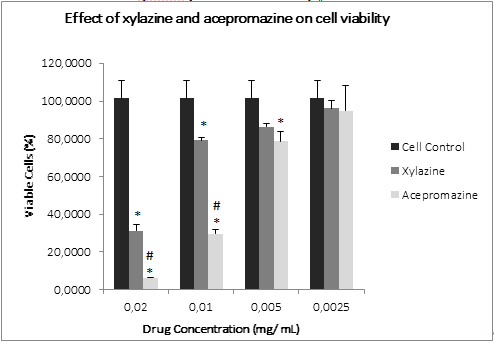Evaluation of the effects of acepromazine and xylazine on viability in an equine dermal cell line
DOI :
https://doi.org/10.21708/avb.2020.14.4.9412Résumé
Xylazine and acepromazine are drugs used exclusively in veterinary medicine. Xylazine is used as a sedative, analgesic, and tranquilizer while acepromazine is used as a sedative, pre-anesthetic, and anesthetic adjuvant. In vitro drug toxicity experimentation is essential to predict possible damage associated with treatment. This study was carried out to evaluate and compare the in vitro effects of acepromazine and xylazine on cell viability. Equine Dermis cells lines were used to examine different drug concentrations (0.02 mg/mL, 0.01 mg/mL, 0.005 mg/mL and 0.0025 mg/mL). An MTT assay was carried out to reveal cell viability. Both tested drugs reduced the viability of ED cells at 0.02 and 0.01 mg/mL. At 0.005 mg/mL, only acepromazine presented an effect. These results corroborate previous studies with xylazine. On the other hand, this is the first report about acepromazine and cell viability. Previous studies suggest that the mechanisms involved in reducing cell viability are apoptosis for xylazine and the activation of the autophagic pathway for acepromazine. Both mechanisms have been seen in other drugs of the same classes. These findings reveal that both acepromazine and xylazine cause concentration-dependent cytotoxicity in vitro. Future experiments could further elucidate the mechanisms by which this effect happens and thus circumvent the risk of potential tissue damage in vivo.
Téléchargements

Téléchargements
Publié-e
Numéro
Rubrique
Licence
Autores que publicam na Acta Veterinaria Brasilica concordam com os seguintes termos: a) Autores mantém os direitos autorais e concedem à revista o direito de primeira publicação, com o trabalho simultaneamente licenciado sob a Licença Creative Commons Attribution que permite o compartilhamento do trabalho com reconhecimento da autoria e publicação inicial nesta revista. b) Autores têm autorização para assumir contratos adicionais separadamente, para distribuição não-exclusiva da versão do trabalho publicada nesta revista (ex.: publicar em repositório institucional ou como capítulo de livro), com reconhecimento de autoria e publicação inicial nesta revista. c) Autores têm permissão e são estimulados a publicar e distribuir seu trabalho online (ex.: em repositórios institucionais ou na sua página pessoal) a qualquer ponto antes ou durante o processo editorial, já que isso pode gerar alterações produtivas, bem como aumentar o impacto e a citação do trabalho publicado (Veja O Efeito do Acesso Livre).


 Esta obra está licenciada com uma Licença
Esta obra está licenciada com uma Licença 